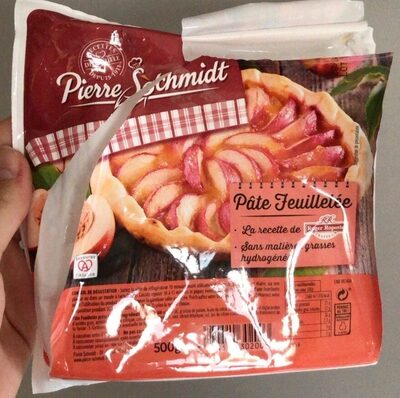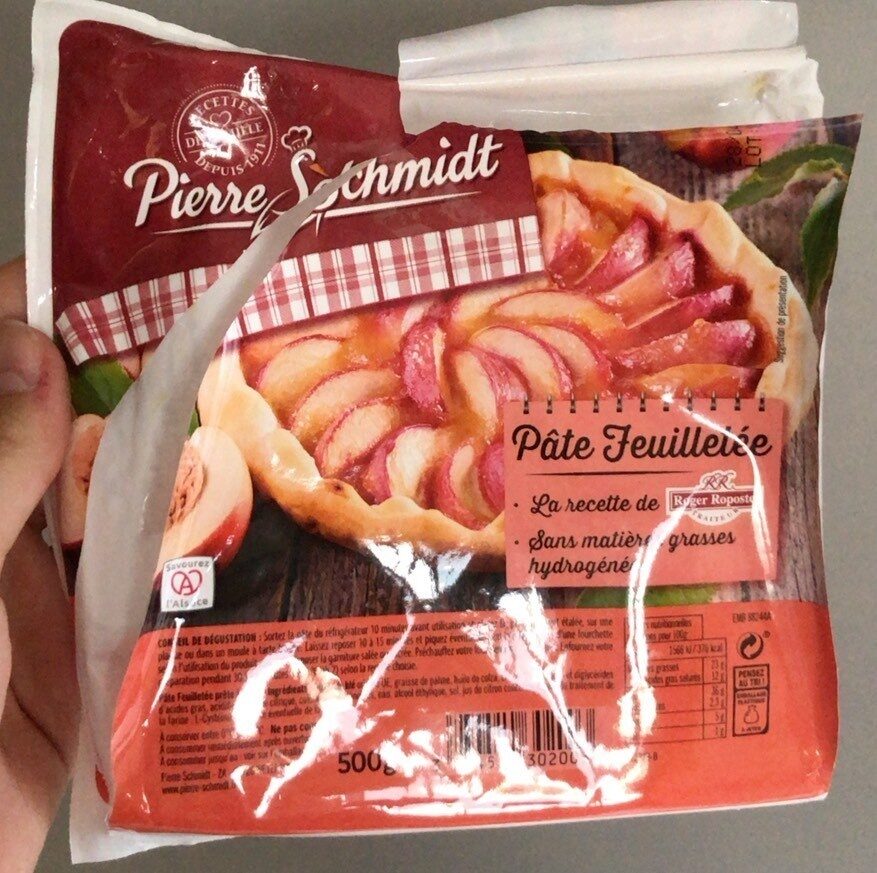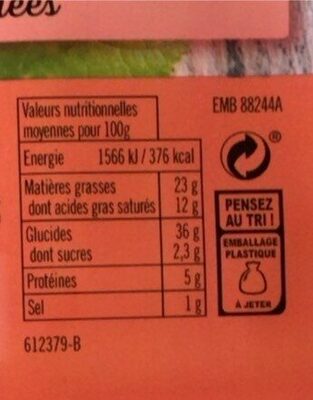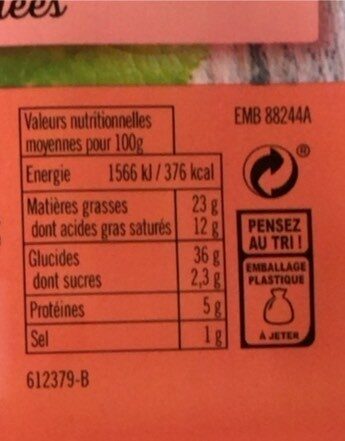Help us make food transparency the norm!
As a non-profit organization, we depend on your donations to continue informing consumers around the world about what they eat.
The food revolution starts with you!
Pâte feuilletée - ROGER ROPOSTE - 500 g
Pâte feuilletée - ROGER ROPOSTE - 500 g
This product page is not complete. You can help to complete it by editing it and adding more data from the photos we have, or by taking more photos using the app for Android or iPhone/iPad. Thank you!
×
Barcode: 3234510302003 (EAN / EAN-13)
Common name: Pâte Feuilletée avec de la matière grasse végétale
Quantity: 500 g
Packaging: fr:Emballage plastique
Brands: ROGER ROPOSTE
Categories: Plant-based foods and beverages, Plant-based foods, Cereals and potatoes, Cereals and their products, Pie dough, Puff pastry sheets
Labels, certifications, awards:
Green Dot
Traceability code: EMB 88244 - Houssière (Vosges, France), EMB 88244A - Houssière (Vosges, France)
Countries where sold: France
Matching with your preferences
Health
Ingredients
-
18 ingredients
: Farine de blé, graisses et huiles végétales (palme, colza), émulsifiant : mono - et diglycérides d'acides gras, acidifiant : acide citrique, colorant : caroténoïdes, eau, alcool éthylique, sel, conservateur : sorbate de potassium, jus de citron concentré, agent de traitement de la farine L-Cystéine.Allergens: Eggs, Gluten, SoybeansTraces: Eggs, Milk
Food processing
-
Ultra processed foods
Elements that indicate the product is in the 4 - Ultra processed food and drink products group:
- Additive: E160 - Carotenoids
- Additive: E471 - Mono- and diglycerides of fatty acids
- Ingredient: Colour
- Ingredient: Emulsifier
Food products are classified into 4 groups according to their degree of processing:
- Unprocessed or minimally processed foods
- Processed culinary ingredients
- Processed foods
- Ultra processed foods
The determination of the group is based on the category of the product and on the ingredients it contains.
Additives
-
E1510 - Ethanol
Ethanol: Ethanol, also called alcohol, ethyl alcohol, grain alcohol, and drinking alcohol, is a chemical compound, a simple alcohol with the chemical formula C2H5OH. Its formula can be also written as CH3−CH2−OH or C2H5−OH -an ethyl group linked to a hydroxyl group-, and is often abbreviated as EtOH. Ethanol is a volatile, flammable, colorless liquid with a slight characteristic odor. It is a psychoactive substance and is the principal type of alcohol found in alcoholic drinks. Ethanol is naturally produced by the fermentation of sugars by yeasts or via petrochemical processes, and is most commonly consumed as a popular recreational drug. It also has medical applications as an antiseptic and disinfectant. The compound is widely used as a chemical solvent, either for scientific chemical testing or in synthesis of other organic compounds, and is a vital substance used across many different kinds of manufacturing industries. Ethanol is also used as a clean-burning fuel source.Source: Wikipedia
-
E202 - Potassium sorbate
Potassium sorbate (E202) is a synthetic food preservative commonly used to extend the shelf life of various food products.
It works by inhibiting the growth of molds, yeast, and some bacteria, preventing spoilage. When added to foods, it helps maintain their freshness and quality.
Some studies have shown that when combined with nitrites, potassium sorbate have genotoxic activity in vitro. However, potassium sorbate is generally recognized as safe (GRAS) by regulatory authorities.
-
E330 - Citric acid
Citric acid is a natural organic acid found in citrus fruits such as lemons, oranges, and limes.
It is widely used in the food industry as a flavor enhancer, acidulant, and preservative due to its tart and refreshing taste.
Citric acid is safe for consumption when used in moderation and is considered a generally recognized as safe (GRAS) food additive by regulatory agencies worldwide.
-
E471 - Mono- and diglycerides of fatty acids
Mono- and diglycerides of fatty acids (E471), are food additives commonly used as emulsifiers in various processed foods.
These compounds consist of glycerol molecules linked to one or two fatty acid chains, which help stabilize and blend water and oil-based ingredients. E471 enhances the texture and shelf life of products like margarine, baked goods, and ice cream, ensuring a smooth and consistent texture.
It is generally considered safe for consumption within established regulatory limits.
-
E920 - L-cysteine
Cysteine: Cysteine -symbol Cys or C; - is a semi-essential proteinogenic amino acid with the formula HO2CCH-NH2-CH2SH. The thiol side chain in cysteine often participates in enzymatic reactions, as a nucleophile. The thiol is susceptible to oxidation to give the disulfide derivative cystine, which serves an important structural role in many proteins. When used as a food additive, it has the E number E920. It is encoded by the codons UGU and UGC. Cysteine has the same structure as serine, but with one of its oxygen atoms replaced by sulfur; replacing it with selenium gives selenocysteine. -Like other natural proteinogenic amino acids cysteine has -L- chirality in the older D/L notation based on homology to D and L glyceraldehyde. In the newer R/S system of designating chirality, based on the atomic numbers of atoms near the asymmetric carbon, cysteine -and selenocysteine- have R chirality, because of the presence of sulfur -resp. selenium- as a second neighbor to the asymmetric carbon. The remaining chiral amino acids, having lighter atoms in that position, have S chirality.-Source: Wikipedia
Ingredients analysis
-
Palm oil
Ingredients that contain palm oil: Palm oil
-
Maybe vegan
Ingredients that may not be vegan: Fat, E471, E160, E920
-
Maybe vegetarian
Ingredients that may not be vegetarian: Fat, E471, E160, E920
-
Details of the analysis of the ingredients
: Farine de blé, graisses, huiles végétales de palme, huiles végétales de colza, émulsifiant (mono- et diglycérides d'acides gras), acidifiant (acide citrique), colorant (caroténoïdes), eau, alcool éthylique, sel, conservateur (sorbate de potassium), jus de citron concentré, agent de traitement de la farine (L-Cystéine)- Farine de blé -> en:wheat-flour - vegan: yes - vegetarian: yes - ciqual_proxy_food_code: 9410 - percent_min: 7.69230769230769 - percent_max: 100
- graisses -> en:fat - vegan: maybe - vegetarian: maybe - from_palm_oil: maybe - percent_min: 0 - percent_max: 50
- huiles végétales de palme -> en:palm-oil - vegan: yes - vegetarian: yes - from_palm_oil: yes - ciqual_food_code: 16129 - percent_min: 0 - percent_max: 33.3333333333333
- huiles végétales de colza -> en:colza-oil - vegan: yes - vegetarian: yes - from_palm_oil: no - ciqual_food_code: 17130 - percent_min: 0 - percent_max: 25
- émulsifiant -> en:emulsifier - percent_min: 0 - percent_max: 20
- mono- et diglycérides d'acides gras -> en:e471 - vegan: maybe - vegetarian: maybe - from_palm_oil: maybe - percent_min: 0 - percent_max: 20
- acidifiant -> en:acid - percent_min: 0 - percent_max: 16.6666666666667
- acide citrique -> en:e330 - vegan: yes - vegetarian: yes - percent_min: 0 - percent_max: 16.6666666666667
- colorant -> en:colour - percent_min: 0 - percent_max: 14.2857142857143
- caroténoïdes -> en:e160 - vegan: maybe - vegetarian: maybe - percent_min: 0 - percent_max: 14.2857142857143
- eau -> en:water - vegan: yes - vegetarian: yes - ciqual_food_code: 18066 - percent_min: 0 - percent_max: 12.5
- alcool éthylique -> en:e1510 - vegan: yes - vegetarian: yes - percent_min: 0 - percent_max: 11.1111111111111
- sel -> en:salt - vegan: yes - vegetarian: yes - ciqual_food_code: 11058 - percent_min: 0 - percent_max: 1
- conservateur -> en:preservative - percent_min: 0 - percent_max: 1
- sorbate de potassium -> en:e202 - vegan: yes - vegetarian: yes - percent_min: 0 - percent_max: 1
- jus de citron concentré -> en:concentrated-lemon-juice - vegan: yes - vegetarian: yes - ciqual_food_code: 2028 - percent_min: 0 - percent_max: 1
- agent de traitement de la farine -> en:flour-treatment-agent - percent_min: 0 - percent_max: 1
- L-Cystéine -> en:e920 - vegan: maybe - vegetarian: maybe - percent_min: 0 - percent_max: 1
Nutrition
-
Poor nutritional quality
⚠ ️Warning: the amount of fiber is not specified, their possible positive contribution to the grade could not be taken into account.⚠ ️Warning: the amount of fruits, vegetables and nuts is not specified on the label, it was estimated from the list of ingredients: 5This product is not considered a beverage for the calculation of the Nutri-Score.
Positive points: 0
- Proteins: 3 / 5 (value: 5, rounded value: 5)
- Fiber: 0 / 5 (value: 0, rounded value: 0)
- Fruits, vegetables, nuts, and colza/walnut/olive oils: 0 / 5 (value: 5.79176682692308, rounded value: 5.8)
Negative points: 18
- Energy: 4 / 10 (value: 1573, rounded value: 1573)
- Sugars: 0 / 10 (value: 2.3, rounded value: 2.3)
- Saturated fat: 10 / 10 (value: 12, rounded value: 12)
- Sodium: 4 / 10 (value: 400, rounded value: 400)
The points for proteins are not counted because the negative points are greater or equal to 11.
Nutritional score: (18 - 0)
Nutri-Score:
-
Nutrient levels
-
Fat in high quantity (23%)
What you need to know- A high consumption of fat, especially saturated fats, can raise cholesterol, which increases the risk of heart diseases.
Recommendation: Limit the consumption of fat and saturated fat- Choose products with lower fat and saturated fat content.
-
Saturated fat in high quantity (12%)
What you need to know- A high consumption of fat, especially saturated fats, can raise cholesterol, which increases the risk of heart diseases.
Recommendation: Limit the consumption of fat and saturated fat- Choose products with lower fat and saturated fat content.
-
Sugars in low quantity (2.3%)
What you need to know- A high consumption of sugar can cause weight gain and tooth decay. It also augments the risk of type 2 diabetes and cardio-vascular diseases.
Recommendation: Limit the consumption of sugar and sugary drinks- Sugary drinks (such as sodas, fruit beverages, and fruit juices and nectars) should be limited as much as possible (no more than 1 glass a day).
- Choose products with lower sugar content and reduce the consumption of products with added sugars.
-
Salt in moderate quantity (1%)
What you need to know- A high consumption of salt (or sodium) can cause raised blood pressure, which can increase the risk of heart disease and stroke.
- Many people who have high blood pressure do not know it, as there are often no symptoms.
- Most people consume too much salt (on average 9 to 12 grams per day), around twice the recommended maximum level of intake.
Recommendation: Limit the consumption of salt and salted food- Reduce the quantity of salt used when cooking, and don't salt again at the table.
- Limit the consumption of salty snacks and choose products with lower salt content.
-
-
Nutrition facts
Nutrition facts As sold
for 100 g / 100 mlAs sold
per serving (100g)Compared to: Puff pastry sheets Energy 1,573 kj
(376 kcal)1,570 kj
(376 kcal)-0% Fat 23 g 23 g +6% Saturated fat 12 g 12 g +6% Carbohydrates 36 g 36 g -6% Sugars 2.3 g 2.3 g +40% Fiber ? ? Proteins 5 g 5 g -15% Salt 1 g 1 g +4% Fruits‚ vegetables‚ nuts and rapeseed‚ walnut and olive oils (estimate from ingredients list analysis) 5.792 % 5.792 %
Environment
-
Eco-Score D - High environmental impact
⚠ ️Select a country in order to include the full impact of transportation.The Eco-Score is an experimental score that summarizes the environmental impacts of food products.→ The Eco-Score was initially developped for France and it is being extended to other European countries. The Eco-Score formula is subject to change as it is regularly improved to make it more precise and better suited to each country.Life cycle analysis
-
Average impact of products of the same category: B (Score: 62/100)
Category: Puff pastry, cooked
Category: Puff pastry, cooked
- PEF environmental score: 0.41 (the lower the score, the lower the impact)
- including impact on climate change: 3.63 kg CO2 eq/kg of product
Stage Impact Agriculture
70.7 %Processing
9.3 %Packaging
5.5 %Transportation
4.0 %Distribution
2.2 %Consumption
8.3 %
Bonuses and maluses
-
Missing origins of ingredients information
Malus: -5
⚠ ️ The origins of the ingredients of this product are not indicated.
If they are indicated on the packaging, you can modify the product sheet and add them.
If you are the manufacturer of this product, you can send us the information with our free platform for producers.
-
Ingredients that threatens species
Malus: -10
Contains palm oil
Tropical forests in Asia, Africa and Latin America are destroyed to create and expand oil palm tree plantations. The deforestation contributes to climate change, and it endangers species such as the orangutan, the pigmy elephant and the Sumatran rhino.
-
Packaging with a medium impact
Malus: -10
Shape Material Recycling Impact Packaging Plastic High
Eco-Score for this product
-
Impact for this product: D (Score: 37/100)
Product: Pâte feuilletée - ROGER ROPOSTE - 500 g
Life cycle analysis score: 62
Sum of bonuses and maluses: -25
Final score: 37/100
-
Carbon footprint
-
Equal to driving 1.9 km in a petrol car
363 g CO² per 100g of product
The carbon emission figure comes from ADEME's Agribalyse database, for the category: Puff pastry, cooked (Source: ADEME Agribalyse Database)
Stage Impact Agriculture
78.3 %Processing
4.9 %Packaging
7.5 %Transportation
5.7 %Distribution
1.0 %Consumption
2.6 %
Packaging
-
Packaging with a medium impact
-
Packaging parts
Packaging (Plastic)
-
Packaging materials
Material % Packaging weight Packaging weight per 100 g of product Plastic
-
Transportation
-
Origins of ingredients
Missing origins of ingredients information
⚠ ️ The origins of the ingredients of this product are not indicated.
If they are indicated on the packaging, you can modify the product sheet and add them.
If you are the manufacturer of this product, you can send us the information with our free platform for producers.Add the origins of ingredients for this product Add the origins of ingredients for this product
Threatened species
-
Contains palm oil
Drives deforestation and threatens species such as the orangutan
Tropical forests in Asia, Africa and Latin America are destroyed to create and expand oil palm tree plantations. The deforestation contributes to climate change, and it endangers species such as the orangutan, the pigmy elephant and the Sumatran rhino.
Report a problem
-
Incomplete or incorrect information?
Category, labels, ingredients, allergens, nutritional information, photos etc.
If the information does not match the information on the packaging, please complete or correct it. Open Food Facts is a collaborative database, and every contribution is useful for all.
Data sources
Product added on by kiliweb
Last edit of product page on by roboto-app.
Product page also edited by bzvanessa, date-limite-app, desan, openfoodfacts-contributors, packbot, quechoisir, teolemon, yuka.UzU5ZlFmNWUrL1FHbXRveDNUV05vdkJhd3FLdEFXT3RGdE0xSVE9PQ, yuka.sY2b0xO6T85zoF3NwEKvlmN3Xt3api35awDvmkSpw-vTArLyMN9t8tH6NKg.











